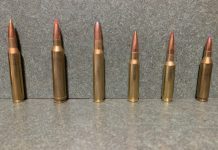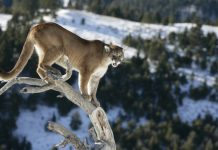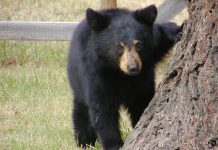
Traditional predator hunting rules tell you to find a high vantage point, sit against a bush, put the sun at your back, and the wind in your face. What if I told you that bending a few of those rules may help you put a few more furs in your truck?
In Arizona and much of the Southwest, desert flats take up a large amount of the terrain. Years ago as I passed these areas and watched coyotes appear and disappear into the creosote bushes. I wondered why I was not calling these areas. Traditional thought ruled them out, since sitting down in a flat leaves your line of site too close. Years went by and I continued to pass these areas sticking to my traditional sets; perched high atop a hill. It wasn’t until I misjudged the terrain gradients and vegetation of some new country that I found myself in a creosote flat too thick to sit down. I suddenly thought to myself, “Now if only I could just stay standing.” That’s when I asked, “Why not?” I picked a bush as tall as me to stand next to, put the FOXPRO electronic call out in front of me within sight and let it scream.
Two minutes later I caught movement to my right. Sure enough, I had a player. I watched as the coyote hastily slipped through the bushes in search of his meal. At 30 yards I made a quick yip, followed it with a bang, and then a flop. KiYi’s erupted from the caller on the report, and were followed thereafter with more rabbit distress. Although I was excited about the outcome of my impromptu stand, I knew it was still early and more ears may still be out there. My hopes were met at the eight-minute mark when a second coyote began his final approach from twelve o’clock. Not wanting to let him get too close to the call, I pulled the trigger on the shotgun when he hit the 40-yard mark. Just like that I had my first flat land double, and it forever changed my view of the flats.
Since that first successful day, I have learned a few things. On a seated traditional stand I always carry a shotgun and rifle. However, while standing it is not feasible to man both guns effectively. Realizing this, I first thought the shotgun would be the best choice for these areas, given much of the area is only visible up to about 75 yards. Unfortunately, I soon realized through missed opportunities the scattergun would have to go. On the other hand, taking offhand shots with a rifle at anything beyond 50 yards, with your adrenaline pumping, is shaky at best. I knew I would need some kind of support system to stabilize the rifle while standing. I ended my search with a simple, yet stout, monopod. Using the monopod gave me a steady rest out to 200 yards. In the flats that’s typically more than enough.
The monopod also provides mobility. While standing, scanning 360 degrees is easy and requires minimal movement. This mobility has allowed me to catch a number of sneaky predators trying to slip around the back. Additionally, the rifle choice itself is also different when in the flats. I love a good heavy barreled rifle while seated. I’ll happily lug a 14-pounder with me to my seated sets where a 500-yard shot is a real possibility. In the flats, such a gun only slows your reaction speed when adjusting to fast approaching predators. In these situations, a light compact rifle is far better. My rifle of choice tips the scales at just 7.5 pounds, and is topped with a 2.5 to 8 power scope. I always start my stand with the scope on the lowest power setting for the same reason I start my traditional sets dialed to six. These are the settings needed when an animal is at its closest range. What do I mean by that? When I carry both a shotgun and rifle, the closest range I use my rifle at is about 60 yards. Any closer than 60 yards and I use the shotgun. However, when only carrying a rifle I may have to take shots at 20 yards or less, which requires the largest field of view possible.
Also, electronic calls are very helpful in the flats, but not necessary. I like them because they move the sound, as well as the predators’ attention, away from you. Using hand calls can also be effective though. When using an electronic call I place it the same way I have always done; in front of me, slightly upwind, calling to a crosswind, and far enough away to provide me with an easy shot should an animal end up right next to it. Without a shotgun for quick moving shots, I mute the sound when I see an approaching animal, which usually slows. This enables me to stop them with a yip before the shot.
One thing that remains unchanged with stand-up calling is the necessity of a good backdrop to hide your silhouette. Regardless of how much camouflage you have, a coyote has an uncanny ability to identify a human profile. I first learned just how much on a hunt in Southern Arizona where I pulled in a highly committed coyote from my left. I stood next to an eight-foot tall bush that hid my profile, and which set the call 30 yards out to my right. The bush hid my profile from all but one angle. Even though fully committed, and with all of his attention on the call, the second he got to that angle he hit the brakes and looked right at me. The jig was up – for him at least.
Even though I went home with the coyote that day, I knew luck was on my side. I realized just how critical hiding your profile is to a successful stand in the flats.
I may have stumbled on the flats years ago by chance, but I’ve been stumbling back on purpose ever since. Try bending the rules yourself and you may just find that the flatlands have more to offer than just creosote.















